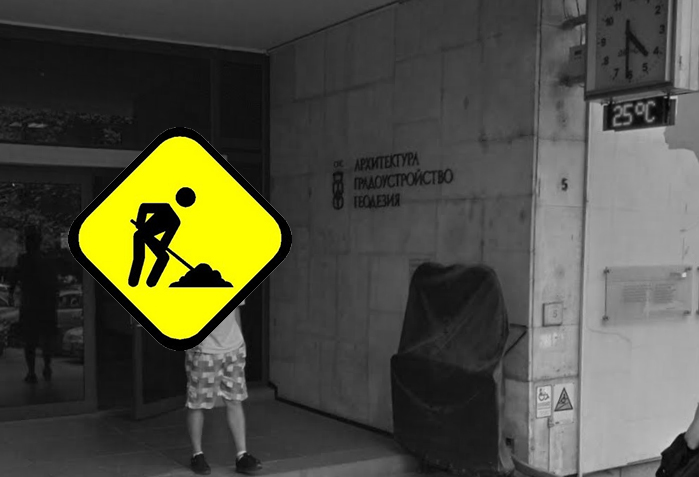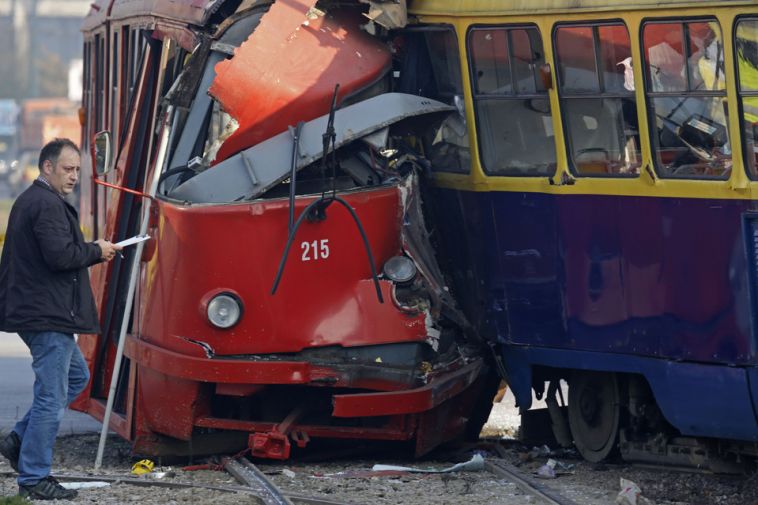| A Foreigners and Friends article |

New trams should not be crossing tracks like these.
Five brand new trams from Poland were recently delivered to Sofia, bringing the total number of new ones to 25. In part, those trams were funded by the European Union’s Project for Integrated Urban Transport. Sofia Municipality fails to inform the country about that project, even though it supplied new trolley buses too, which have improved the quality of public transport substantially, in areas where they are in operation.
But there are huge problems. One of the most serious ones is the deteriorating state of the tram tracks to Sofia’s Darvenitsa quarter, which not so long ago swallowed 20 million Leva. Also, part of the funds from the E.U. project for Integrated Urban Transport was spent on the repairs of the tram track on Boulevard Bulgaria. „Spasi Sofia“ has reported about the outrageous state those are in quite often. The organization even informed the European Commission about what is going on here.
The recent repair works were divided into two phases, the first of which was completed two years ago. It is still unclear, when and if the second one will commence. But, the tracks on the remaining 500 meters are so bad, they are literally breaking the new trams. „Spasi Sofia“ is wondering why the city would buy new trams, if they roll over tracks, which are unsupported, falling apart and actually dangerous.
Twenty-five new trams may not seem to be many, as part of a fleet with a total of 270 trams. But they did cost a lot of money, 3.35 million Leva a piece, to be precise, and they are supposed to last for decades. On tram line no. 7, passengers felt like real Europeans, at least briefly, until the repaired stretches started crumbling away again.
No, this is not about „arrogant expats“ complaining about things. „Spasi Sofia“ („Save Sofia“) is a Bulgarian NGO in the capital, which shows the public and City Hall what needs to be done. When Sofia Municipality does not notice grave problems right in front of their window, they can check „Spasi Sofia“. This organization has made a difference, e.g. by fighting for the third Metro line, until the city started building it. This is their latest report on tram tracks.
Our latest photo shoot (see all those pics) demonstrates what condition the tracks are in and at what speed, with how much comfort, the passengers were transported. We started on the southern end of the Bulgaria Boulevard. Due to the planned construction works at the intersection of Bulgaria Boulevard and Boulevard Geshov, the municipality had postponed the renovation of those 500 meters of tram tracks for a year. But that was in 2015, and the intersection construction never happened. Therefore, every single pass of a tram is an adventure, involving a lot of noise, vibration and weaving. How European!
Ready for the next problem? Only last summer, big repairs were done at the junction of Boulevards Bulgaria and Vitosha. Those were not done properly at all, and huge holes around the railway stitches have opened. The joints, the noise, the vibration as well as the broken connection between the asphalt and the concrete amount to yet another serious problem. Only one year after the so-called repairs, the condition of those streets and tracks is completely unacceptable. We recall that the lifetime of overhauled tracks usually is 20 years. In Sofia, we have to wait 30 to 40 years.
Following tram line no 7, we got to Boulevard Hristo Botev, where we were in for more unpleasant surprises. The first one hit us at Macedonia Square, a key junction for Sofia’s tram system, with lots of traffic. Huge holes are gaping there. All switches and rails are basically naked, with no insulation left. There are numerous patches, signs of the annual repairs, which were obviously designed to last half a day, until noon. The status is simply unacceptable, especially at one of the most important spots in Sofia. The damage is also visual evidence of the irresponsible attitude at Sofia Municipality, in connection with the oldest and most ecological form of public transport.
The tram route on Boulevard Hristo Botev itself is also heavily depreciated. The speed of the trams is therefore reduced, on this important corridor. This especially applies since the tram tracks on Vitosha Boulevard were removed, when the street was turned into a pedestrian zone. Speed and safety are further reduced. Also, there is a lack of tram stops in the section used by six lines (1, 3, 6, 7, 8 and 10), as well as constant violations of the right of way for trams on the part of undisciplined drivers and pedestrians.
Through holes, with a lot of noise and still at crawling speed, we arrived at another crucial juncture, the Central Railway Station Sofia. If the management of public transport in the city was responsible and professional, it would be an extremely busy spot. But not in Sofia. Tram lines 1, 3, 6, 7 and 12 come here, but the track condition is extremely bad. The pictures do not need explanation, but the mayor, Mrs. Fandakova, should definitely look at them and wonder if talking about big investments in public transport reflects its actual condition. Or is this just wishful thinking? There might be a lack of real knowledge of the situation, and a lack of courage to realize that there are severe problems.
We are reaching the end of the tram line at Boulevard Maria Luiza. This is where the lines towards the northern neighbourhoods of Sofia commence. The tracks are in a dangerous condition, actually the worst in the city. The rails have fallen through holes filled with soil, as a result of their deformed base. Because of the terrible state, the trams are moving very slowly here. Even that does not decrease the vibration and noise.
The purpose of this stroll along the tracks was to illustrate what the real state of one of the most important tram corridors in the city is. We hope Mayor Yordanka Fandakova and responsible people at in Sofia Municipality will finally understand that simply purchasing 25 new trams will neither reform public transport, nor make it a preferred form of travel for local residents. Large-scale investments in the transport infrastructure and quality renovations are needed. Also, the tram corridors need to be separated from the cars and pedestrians. On top of that, the tram schedules need to be compressed. And the trams themselves need to become faster, more comfortable and more regular.




